Song of India (Dracaena reflexa) is a tropical tree native to islands of the Indian ocean, including Mozambique, Madagascar, and Mauritius. This popular plant can be grown indoors, and thanks to its easy growth habits, it’s a great choice for beginner plant parents (just keep in mind that it’s toxic to pets like dogs and cats).1 It has alternating dark green and chartreuse stripes on narrow, lanceolate leaves with veins that run parallel along their length. These leaves are in a whorled arrangement, gradually dying off to reveal a stem with an interesting pattern.
This broadleaf evergreen will often grow 12 to 20 feet tall in the wild, but it can be an adaptable plant when grown indoors. It will suit your needs as either a tabletop or floor specimen. As a houseplant, Song of India will reach a maximum height of 3 to 6 feet. It’s best to plant this species during the spring growing season, and plant parents can expect it to grow about 4 inches each year.
If you choose to grow Song of India, you’ll be rewarded with a beautiful, slow-growing plant that is easy to grow and propagate from cuttings.
Common NameSong of IndiaBotanical NameDracaena reflexaFamilyAsparagaceaePlant Type Perennial, shrubMature Size3-20 ft. tall, 3 ft. wideSun ExposurePartialSoil TypeMoist but well-drainedSoil pHNeutralBloom TimeWinterFlower ColorWhiteHardiness Zones10-12 (USDA)Native Area AfricaToxicityToxic to dogs and cats




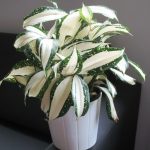

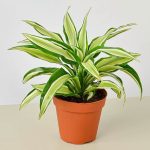

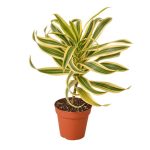

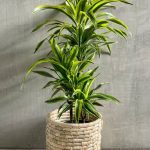

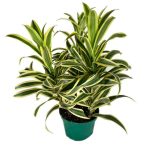

Song of India Care
Song of India is known for its easy-growing habits, like many of the plants within the Dracaena genus. The key to keeping this species healthy is to keep its care balanced: Provide consistent temperatures for it to grow (between 65 and 75 degrees Fahrenheit), indirect sunlight, and allow the soil to dry somewhat between waterings.
This plant’s simple care requirements are largely thanks to its tolerance to low-water conditions. However, while your Song of India can survive periods of drought, it’s best to provide moist soil with plenty of drainage to allow your plant to absorb what it needs.
Light
Song of India requires bright, indirect sunlight for at least four hours per day. Your plant’s foliage will become more vibrant in coloration with these conditions, but take note that too much sun is also harmful. It can cause leaf scorch, which will appear as browning of the leaf tips and margins.
Soil
Song of India is not very particular about soil. A peaty, well-drained potting mix is best. Remember that more peat in the plant’s soil will cause the soil to decompose faster: Alleviate this issue by repotting your plant as needed (about once per year each spring) to change its soil. One way to remedy this is by making a potting mix of your own with bark, peat, pumice, vermiculite, and perlite.
Water
Water your plant often enough to keep its soil moist, but not soaked, from spring through fall. Song of India requires less water in the winter. Never overwater this plant, as it’s especially susceptible to root rot. One issue to be aware of is the genus’ sensitivity to fluoride: A good practice is to use bottled or purified water for your plants. A symptom of fluoride damage is yellow wilting on the leaf margins.
Temperature and Humidity
When keeping this plant indoors, normal room temperatures from 65 to 75 degrees Fahrenheit are perfect for Song of India. This species is native to the warm climate of the Indian Ocean, and it does not tolerate cold well; even a slight draft near a cold window can do serious harm. If you live in USDA Hardiness Zones 10-12, you can grow it outdoors in partial shade.
Fertilizer
The Song of India should be fed bi-weekly in the spring and summer with a water-soluble 10-10-10 fertilizer diluted by half. No feeding is needed during the winter months.
Types of Song of India
Most of the 120 plants in Song of India’s genus come from Africa, and many of its species are kept as houseplants thanks to their tolerance of low-light and low-water conditions. Dracaena reflexa was first described by famed French naturalist Jean-Baptiste Lamarck in 1786. Though it has gone through several name changes since then, its genus name Dracaena comes from the Greek word drakaina, meaning “female dragon.” In this particular species, there are several cultivars:
Dracaena reflexa ‘Variegata’: This variant has bright, lime-yellow leaf margins that contrast with dark green on the rest of the leaf. The foliage’s light color matures to a creamy white with age, making the contrast even more prominent.
Dracaena reflexa ‘Song of Jamaica’: This rare variant features stems that grow at unusual angles and bend down as the plant matures. Rather than the chartreuse-colored stripes of Song of India, Song of Jamaica’s leaf stripes are more off-white.
Pruning
Song of India does not typically need to be pruned, but plant parents can trim the stems of this species if they grow too long or leggy. Pruning your plant can help encourage fuller growth. Using a clean pair of gardening shears, cut the stem at the base where it protrudes from another stem. At the cut location, new leaves will eventually begin to grow and fill out the plant.
Propagating Song of India
Song of India is not typically grown from seed but can easily be propagated via cuttings. It’s best to propagate this species in the spring when it’s actively growing, and taking cuttings will also help your plant grow fuller. Each cutting can be used to grow a new plant. Here’s how:
Step 1: Gather a clean pair of gardening shears and a small container. Choose either purified water (bottled is an easy option) or a mixture of peat moss and perlite to grow your cutting.
Step 2: Locate a stem at least 6 inches long that you’d like to propagate from your plant. Carefully trim it off using the shears.
Step 3: Place the cutting in its new container in an area with bright, indirect light. This species can be rooted in water, or you can dip the cut end in rooting hormone and plant it in a mixture of equal parts peat moss and perlite. Keep the mixture consistently moist, but not soggy.
Step 4: Once the plant is established (after a few weeks), plant it in a larger container with well-drained soil and care for it as usual.
Potting and Repotting Song of India
While your Song of India plant may need its soil changed out annually (especially when mixed with peat), this species is a slow grower and only needs to be repotted every few years. When your plant is outgrowing its container, choose a pot one size larger with plenty of drainage. Avoid pots that are excessively large, as they may hold in too much moisture. Unglazed ceramic or terracotta pots are helpful, as these porous materials do not trap as much water as plastic or metal pots.
Fill the new pot with the potting medium of your choice and leave space for the plant’s roots in the center. Carefully lift your Song of India from the original pot, shaking away excess soil from its roots. Place the plant in its new pot and fill any empty areas with soil. Thoroughly water the soil, allowing water to drain, then care for it as usual.
Overwintering
Song of India is a tropical plant that can’t survive outdoors in winter in most regions of the United States. If your USDA Hardiness Zone is not recommended for growing this species outside, you’ll need to bring your plant indoors to overwinter it in a safe location.
Place your Song of India in an area of your home that sees consistent temperatures between 65 and 75 degrees. Choose a location a few feet from a south- or west-facing window to overwinter your tropical plant in indirect sunlight without being too close to cold drafts.
Common Pests & Plant Diseases
Pests like spider mites, scale, and mealybugs are known for making homes in Dracaena plants like Song of India. Treat your plant by rubbing its leaves and stems down with insecticidal soap or rubbing alcohol.
Fusarium leaf spot is also common in Dracaena plants. This fungus causes brown spots or tips on the leaves. Applying fungicide to your plant can help prevent any further spread of the fungus on its leaves, and heavily affected leaves should be trimmed from the plant and thrown away.
How to Get Song of India to Bloom
Song of India does not often bloom when grown indoors, but plants grown outside in suitable USDA Hardiness Zones can bloom in late winter. Plenty of bright, indirect sunlight and humidity are essential for this plant to produce its small, white flowers. While it’s very unlikely for this species to flower as a houseplant, providing the right sun exposure and moisture levels may encourage your plant to bloom. Allow the flowers to die naturally and decrease waterings during the winter season.
Common Problems With Song of India
While Song of India is typically regarded as a very easy houseplant to care for, it’s still possible to run into a few common growing problems. Most often, improper light and waterings lead to issues that can be diagnosed by observing the plant’s leaves.
Brown Leaves
Brown leaves on Song of India can indicate that the plant is either receiving too much sun or too much water. Determine which cause is most likely based on your plant’s recent care. If the plant’s leaves are brown, dry, and crispy, it’s likely developing leaf scorch, and it should be moved to a shadier location. On the other hand, brown leaves that aren’t dry can indicate that it’s overwatered.
Yellow and Wilting Leaves
Yellowed leaves are also a sign of overwatering, which can quickly lead to root rot and cause severe damage to the plant. Check your Song of India’s soil: If it’s soggy, the plant should be drained thoroughly or repotted in a fresh soil mixture. Fluoride damage can also cause yellow, wilted leaves, in which case it’s best to switch to purified water rather than using tap water.
Drooping Leaves
When your Song of India is drooping, the plant likely needs less sun and more water. Move the pot to a shadier location and water the plant thoroughly, taking care to allow all excess water to drain completely.
FAQ
Is Song of India an indoor or outdoor plant?
Depending on the region you live in, Song of India can be grown indoors or outdoors throughout the year. Plant growers living in USDA Hardiness Zones 10 through 12 can plant Song of India directly in the ground, while those in zones outside the plant’s hardiness regions should keep this tropical species in a container outside in summer months, if desired, and indoors during colder weather or indoors year-round.
Where Should I Put a Song of India Plant?
Song of India is susceptible to leaf scorch, so direct sunlight should be avoided when choosing a location for this plant. However, this species does best with plenty of bright, indirect sunlight. A spot near an east-facing window or a few feet from a west- or south-facing window is best. Outdoors, the plant prefers a partially shady location.
What Plants are Similar to Song of India?
There are more than 100 plants within the Dracaena genus, and many are similar to Song of India. Dragon trees (Dracaena draco) and corn plants (Dracaena fragrans) also have similar growth habits and easy care requirements.
Sharing is caring!








